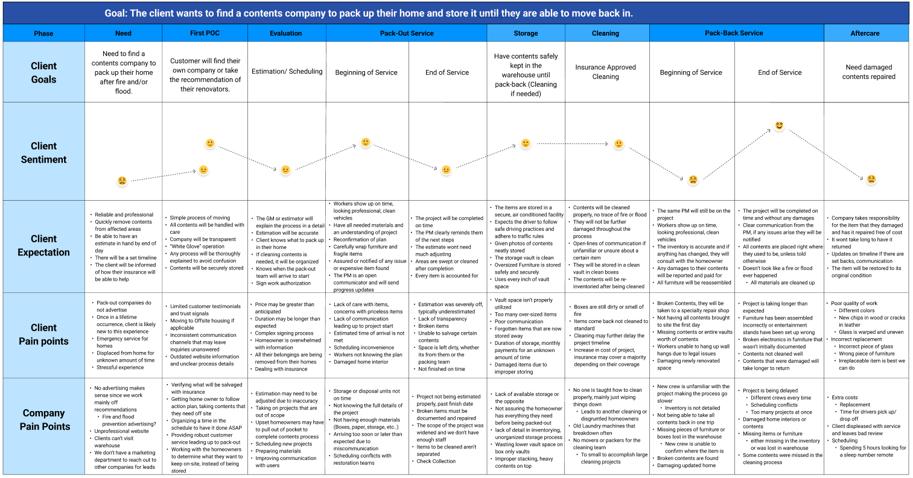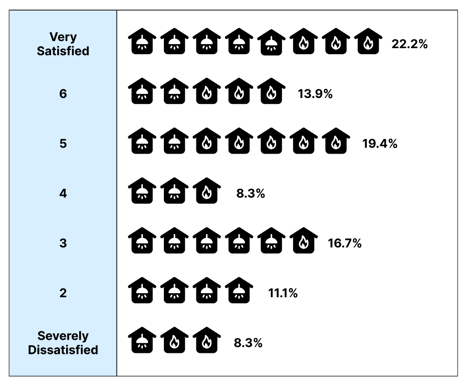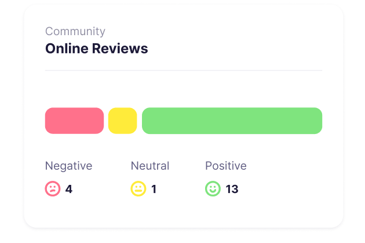
Premier Packout
CX Researcher
Client -
Role -
Premier Packout
CX Researcher
Location -
Scottsdale, Arizona
About -
Premier Packout is a fire and flood contents management company specializing in the handling of salvageable items. We carefully remove belongings from your home or business, ensure they are professionally cleaned and securely stored, and return them to their original location once renovations are finalized.
Premier CX Analysis
Brief -
I collaborated with the CEO to analyze and identify pain points in our customers' journey, focusing on areas that commonly cause unnecessary stress for homeowners. We identified improvements in the packing, storage, cleaning, and pack-back processes, along with timeline estimations and staff management, delivering a more professional, white-glove service.
Identify the Issue -
Proposed Solution -
Miscommunication between insurance companies, restoration companies, homeowners, and adjusters is common, making it crucial to maintain strong relationships throughout the process. The packing, cleaning, storage, and transport of belongings during repairs can be stressful for homeowners, as it involves managing fragile items and dealing with the uncertainty of renovation timelines. Coordinating the logistics of storage, cleaning, and pack-back, while ensuring the safety and security of belongings, adds to the emotional strain for homeowners.
Problem Overview
My recommendations focused on enhancing communication between our renovation partners and our team, streamlining the pack-out process, optimizing storage use, and implementing changes in staff management along with updating the website.
Be clear to the homeowners about timelines
Increase pack-out efficiency by improving the process
Boxes in second level vaults, furniture in ground level
Assign PMs to jobs, become familiar with the homeowner
Potential Strategies -
I conducted individual interviews with the CEO, managers, staff and various homeowners. Through this qualitative data, I could identify pain points and propose solutions.
A professional and modern website is essential, as it serves as one of the first touchpoints for potential customers. The current site lacks key information, features an outdated employee roster, contains multiple bugs, and includes an unused portal. A redesign should not only address these issues but also enhance user experience and credibility. By clearly illustrating our process—from carefully wrapping furniture to expertly packing glass and securely transporting large or high-value items—we can showcase our expertise and instill confidence in our services.
Website -
Staff Appearance -
Work Flow -
Strategic Planning
The CEO envisions the company as a premier "White Glove" service, emphasizing professionalism and excellence. To achieve this, employees will adhere to a strict dress code with a standardized uniform, reinforcing a polished and cohesive brand image. Additionally, company vans require maintenance, including repairs, a fresh coat of paint, and a branded wrap to enhance visibility and serve as mobile advertising, further strengthening the company’s presence. Additionally, maintaining a positive relationship with the homeowner throughout the project is essential.
Our workflow could be significantly more efficient, particularly in inventory management, furniture wrapping, packing, and storage. Delays often stem from overloaded cabinets filled with glassware and china, cluttered rooms, and difficulties in salvaging affected contents. To streamline operations, we should implement strategies to maximize packing efficiency, increase the number of wrapped furniture pieces, and optimize both truck loading and warehouse storage for a smoother, more organized process.
Journey Map -
To create this journey map, I conducted semi-structured interviews with clients to understand their frustrations, combined with observational research of our workflow. I also analyzed customer feedback to identify recurring pain points. By thematically organizing these insights, I was able to visualize bottlenecks and areas for improvement across the service process.
Qualitative Research
Research Methods -
Direct Client & Employee Interviews (Semi-Structured)
Conduct one-on-one interviews with clients and team members involved in the process.
Use open-ended questions to explore their experiences, frustrations, and expectations.
Example:
"Can you describe a time when the service didn’t meet your expectations?"
"What was the most stressful part of the process for you?"
Contextual Inquiry (Observational Research)
Shadow employees with different roles or observe clients reactions to specific events
Observe workflow inefficiencies, unexpected challenges, and workarounds
For Example:
Watching how packers and movers pack fragile items to understand inconsistencies
Understanding the requirements of our inventory system and being able to reduce time spent on inventory
Consistent labeling and documentation (cabinets A-Z, sectional couches, bed parts, photos of plugs for electronics)
Thematic Analysis
Gather qualitative feedback (e.g., interviews, support tickets, reviews).
Look for patterns in common pain points (e.g., delays, miscommunication, damaged goods).
Cluster these themes into different stages of the journey


Online Sentiment -
Satisfaction Pictograph -
The Company has a Google rating of 5.0 based on 2 reviews. However, specific details from these reviews are not available. On Yelp, there is a business listing for Premier Packout, but it does not feature any customer reviews or ratings.
Given the limited number of reviews, it's challenging to provide a comprehensive assessment of the company's reputation. For a more thorough understanding, you might consider reaching out directly to Premier Packout for client references or consulting local community forums for additional insights.
This pictograph visually represents homeowner satisfaction levels following the completion of our services. The data is based on feedback from 36 homeowners, with ratings ranging from "Completely Dissatisfied" to "Completely Satisfied." Each icon in the chart represents one homeowner, providing a clear, intuitive view of overall sentiment. Overall CSAT score, 56%.
Quantitative Research




Website Analysis -
Major -
Website Insights
Broken Hyperlinks: The "Learn How" button leads to a 404 error, disrupting navigation.
Navigation Inconsistencies: The “Our Services” and “Company” buttons incorrectly redirect to the homepage instead of their intended sections.
Brand Recognition Problems: The Yelp logo lacks clear branding, making it unrecognizable. Also, the presence (or absence) of a LinkedIn review section should be clarified.
Address Formatting Concerns: The site displays a PO Box address instead of a personal/business address, which may affect trust and operational clarity.
Lack of Social Proof: There are no customer reviews or testimonials, which reduces credibility. Adding verified client feedback would help build trust and engagement.
Minor -
Employee Photos: Updating staff images would enhance customer trust and verification, making clients feel more secure.
Typography & Formatting: The "Contact Us" section has inconsistent typography and structure, reducing readability. Additionally, overall typography scaling varies across pages, leading to disproportionate text sizing.
Mission Statement & Company Values: Discrepancies in stated company experience ("25 years" vs. "15 years" in fire and flood services) create confusion and should be fact-checked for consistency.
Service Descriptions: Current descriptions are vague and do not clearly convey what the company does or its expertise. Clarifying these would improve customer understanding.
These insights highlight the need for website restructuring and optimization to improve navigation, clarity, and professionalism. Addressing broken links, navigation flaws, and missing testimonials will enhance customer confidence and usability, ultimately leading to a more effective online presence.
To enhance our professional appearance, we propose the following uniform structure:
GM & Higher Management – White collared shirts for a clean, authoritative look.
Project Managers – Navy blue collared shirts to align with company branding.
Lower Staff – Grey collared shirts for uniformity and practicality.
Bottoms – Employees should have the option of both pants and shorts to maintain a professional yet functional dress code.
Uniform & Appearance Improvements -
Staff Professionalism
Company Presentation & Facility Enhancements -
Beyond uniforms, improvements can also be made in company presentation and workspace functionality:
Company Vehicles – Vans should receive regular detailing and be outfitted with professional company wraps to enhance brand visibility and credibility.
Warehouse Organization – A deep clean and improved organization of the warehouse will further contribute to the company’s professional image and efficiency.
Office Renovation – Updating office space to provide a professional setting for in-person client meetings when necessary.
New Rug Storage – Implementing a better rug storage system to improve organization and accessibility.
Designated Cleaning Area – Establishing a specific space for cleaning to maintain efficiency and cleanliness in daily operations.
Staff Overview -
Our company's presence in high-end neighborhoods necessitates a polished and professional image that aligns with the "white glove" standard set by leadership. Currently, staff uniforms lack consistency and professionalism, with stained, mismatched, and unappealing attire. Additionally, the absence of standardized pants and shorts limits the uniform’s versatility.
To enhance our professional appearance, we propose the following uniform structure:
GM & Higher Management – White collared shirts for a clean, authoritative look.
Project Managers – Navy blue collared shirts to align with company branding.
Lower Staff – Grey collared shirts for uniformity and practicality.
Bottoms – Employees should have the option of both pants and shorts to maintain a professional yet functional dress code.
Uniform & Appearance Improvements -
Staff Professionalism
Company Presentation & Facility Enhancements -
Beyond uniforms, improvements can also be made in company presentation and workspace functionality:
Company Vehicles – Vans should receive regular detailing and be outfitted with professional company wraps to enhance brand visibility and credibility.
Warehouse Organization – A deep clean and improved organization of the warehouse will further contribute to the company’s professional image and efficiency.
Office Renovation – Updating office space to provide a professional setting for in-person client meetings when necessary.
New Rug Storage – Implementing a better rug storage system to improve organization and accessibility.
Designated Cleaning Area – Establishing a specific space for cleaning to maintain efficiency and cleanliness in daily operations.
Staff Overview -
Our company's presence in high-end neighborhoods necessitates a polished and professional image that aligns with the "white glove" standard set by leadership. Currently, staff uniforms lack consistency and professionalism, with stained, mismatched, and unappealing attire. Additionally, the absence of standardized pants and shorts limits the uniform’s versatility.
As an urgent-response service, traditional marketing strategies are limited. However, proactive outreach and educational content can help establish our brand and generate leads before emergencies occur.
Preventative Marketing Approach – Implement a content-driven strategy offering home maintenance tips to reduce the risk of floods and fires.
Targeted Ads & SEO – Leverage online ads targeting homeowners in high-risk areas with messaging around prevention and emergency preparedness.
Partnerships & Referral Networks – Build relationships with insurance companies, restoration services, and property managers to create a steady pipeline of work.
Marketing & Work Acquisition -
Operational Workflow
Improving Inventory Efficiency -
Slow inventorying hampers productivity and delays job completion. Streamlining this process will significantly enhance turnover speed.
General Inventory Before Packing – Assign a team member to perform a general inventory of the area before packing begins to create a structured plan.
Location-Based Packing – Items should be grouped together based on their original placement (e.g., from the same cabinet or shelf) rather than being mixed from different locations.
Streamlined Labeling & Room Categorization – Implement a standardized inventory system that categorizes rooms clearly and assigns color-coded or QR-coded labels for easy tracking.
Pre-Labeled Packaging – Utilize standardized packaging and labeling templates to reduce manual input.
Dedicated Inventory Stations – Establish defined workspaces for sorting, logging, and staging items efficiently.
Operational Overview -
To improve efficiency and scale our general packing operations, we must address three critical pain points: lack of marketing/work acquisition, slow inventorying, a poor storage system, and an understaffed cleaning operation.
A disorganized storage system increases retrieval times and causes operational slowdowns. To improve efficiency:
Optimized Box Storage –
Boxes should primarily be packed into upper storage vaults to free up lower vault space for larger furniture pieces.
Boxes should not exceed a specific weight limit to maintain safe handling.
Boxes should be packed with heaviest items on the bottom and lighter items on top to avoid damage.
Job-Specific Packing Zones – Jobs that require cleaning should have their packed contents stored in the cleaning side of the warehouse to minimize unnecessary movement across the warehouse.
Categorized & Color-Coded Storage – Implement a structured system that groups items by category, frequency of use, and urgency.
Vertical Storage Solutions – Maximize space with shelving and modular units for quick access.
Designated Packing Zones – Separate intake, staging, and outbound areas to minimize cross-traffic and confusion.
Storage System Optimization -
Cleaning Operation -
The cleaning team plays a crucial role in maintaining quality standards, but inefficiencies in organization, manpower allocation, and workspace setup are slowing operations. Addressing these issues will improve turnaround time and overall workflow.
Organization & Workflow Efficiency
Implement a dedicated workspace for cleaning, furniture wrapping, and preparation to minimize disruption.
Create a task prioritization system to ensure urgent cleaning jobs are completed on time.
Manpower & Resource Allocation - Establish clear roles and responsibilities within the cleaning team to prevent unnecessary overlap.
Equipment & Tools - Ensure all equipment is regularly maintained and readily available in the dedicated cleaning area.


